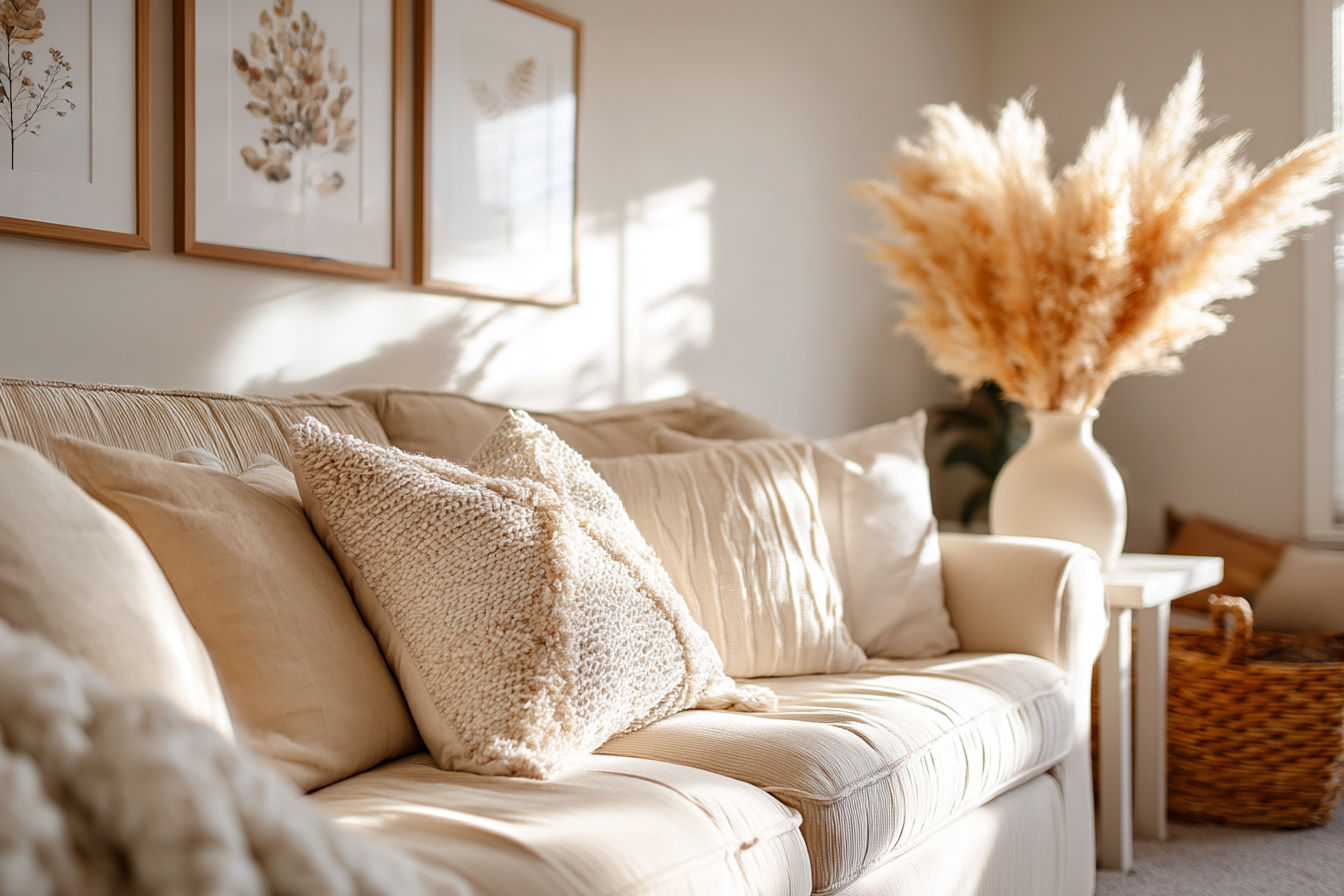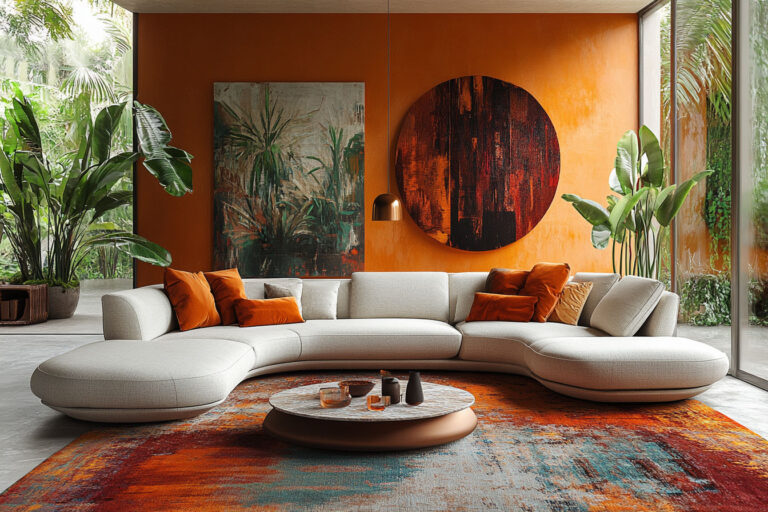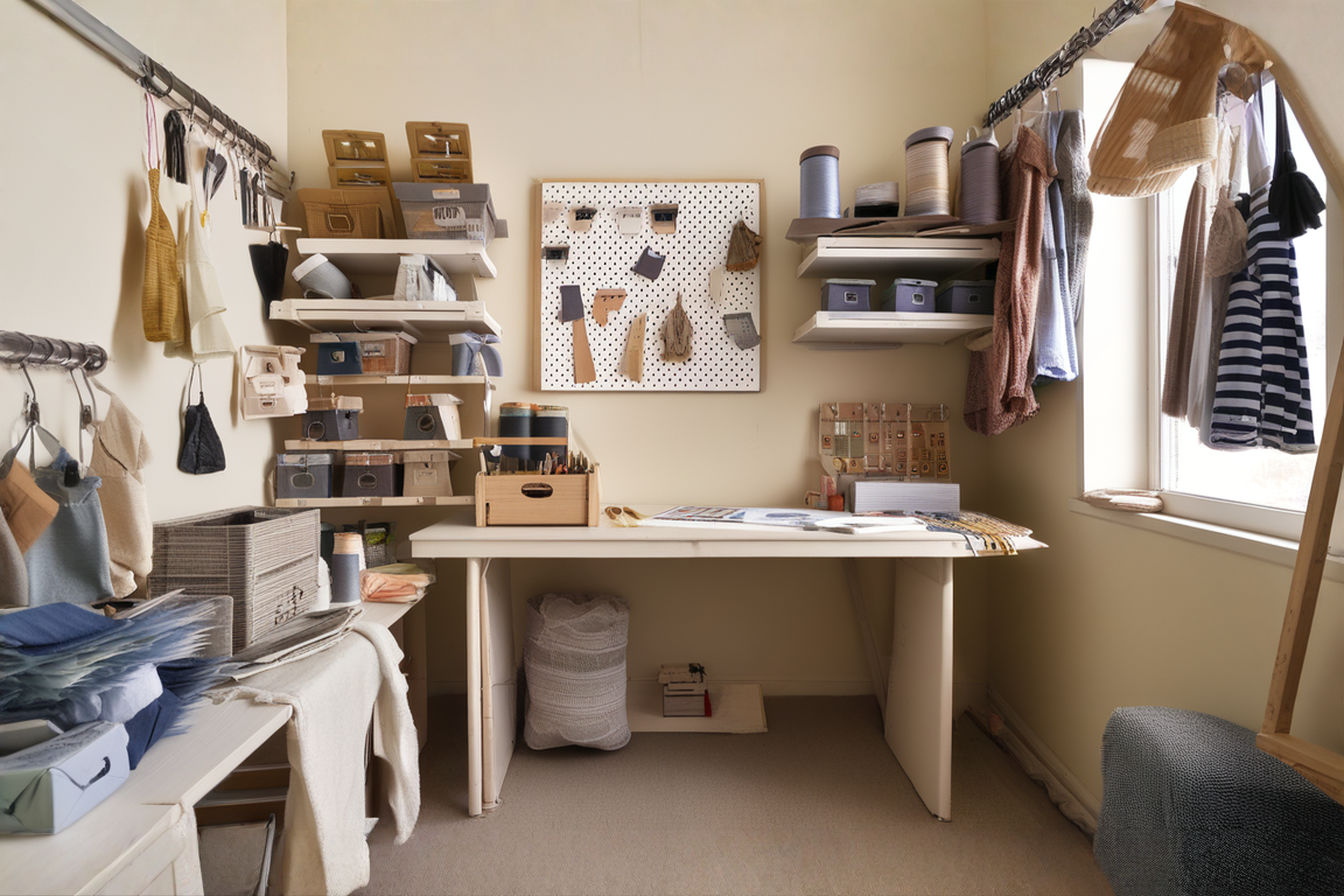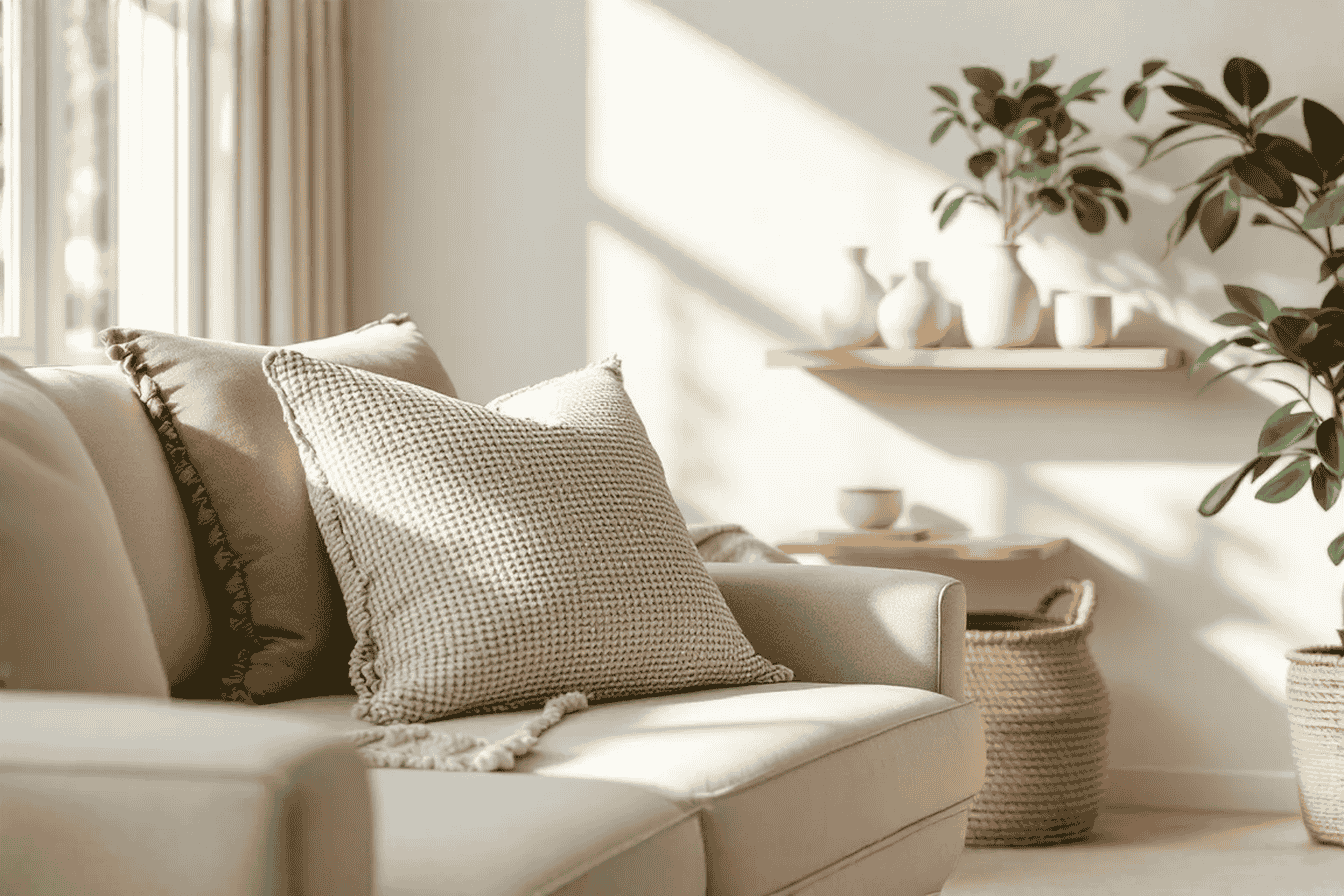This post may contain affiliate links. If you make a purchase through these links, we may earn a commission at no additional cost to you.
The desire to keep our homes feeling fresh and inspiring often collides with the reality of our budgets. While design magazines showcase complete seasonal overhauls, most of us can’t afford to replace furniture and accessories four times a year—let alone monthly. Yet the craving for change persists, especially as seasons shift and our surroundings start to feel stale or disconnected from the world outside our windows.
This disconnect creates a common dilemma: how do we satisfy our need for novelty and seasonal appropriateness without draining our bank accounts? The solution lies in strategic, affordable monthly updates that create maximum impact with minimal investment. By focusing on key changeable elements and developing a rotation system, you can enjoy a refreshed home environment every month without accumulating excess or overspending.
In this comprehensive guide, we’ll explore eight proven approaches to affordable monthly decor updates, complete with practical examples, sourcing suggestions, and implementation strategies. These methods work in homes of any size and can be scaled to fit virtually any budget. Let’s discover how small, intentional changes can transform your living space throughout the year.
The Psychology of Seasonal Decor
Our connection to seasonal changes runs deeper than mere aesthetics. Research in environmental psychology suggests that our surroundings significantly impact our mood, energy levels, and overall sense of well-being. When our indoor environment acknowledges and celebrates the natural rhythms happening outside, we experience greater harmony and satisfaction with our living spaces.
Studies have shown that refreshed surroundings can boost dopamine—the neurotransmitter associated with pleasure and satisfaction. This explains why walking into a newly cleaned room or a space with a few thoughtful changes can instantly lift your spirits. The novelty factor stimulates your brain, creating a renewed appreciation for your home.
Regular decor updates offer multiple psychological benefits. They prevent the “blind spot syndrome” where we stop noticing our surroundings due to familiarity. These changes increase our appreciation for what we already own by presenting items in new contexts. Additionally, the creative process of rearranging and restyling stimulates our imagination and problem-solving abilities.
Setting realistic expectations for monthly updates is essential. Rather than overwhelming changes, think of these adjustments as gentle refreshes that acknowledge the shifting light, temperature, and mood of each month. Sometimes the most impactful changes are subtle ones that work with your senses—like introducing a new seasonal scent or adjusting your lighting to mirror the natural light patterns outside.
Creating a Flexible Foundation
Successful seasonal decorating begins with a thoughtful foundation. This doesn’t mean investing in expensive, trend-focused pieces, but rather choosing items that provide versatility throughout the year. Neutral base pieces serve as the canvas for your seasonal expressions, allowing changeable elements to stand out.
When selecting furniture, prioritize clean-lined pieces in neutral tones like beige, gray, white, or natural wood finishes. These choices create a timeless backdrop that accommodates seasonal color shifts. Consider the texture as well—a bouclé sofa can feel cozy in winter but still work in summer when paired with lighter accessories. Multi-functional pieces like storage ottomans or nesting tables offer flexibility for different seasonal arrangements.
Understanding basic color theory helps create cohesive seasonal transitions. Warm tones (red, orange, yellow) generally evoke fall and winter coziness, while cool tones (blue, green, purple) can feel refreshing for spring and summer. However, the intensity and specific shade matter too—a deep emerald might feel wintry while a light sage works perfectly for spring.
The key distinction in seasonal decorating is between investment pieces and changeable accents. Investment pieces should withstand the test of time in both durability and style. These include sofas, dining tables, bed frames, and quality storage pieces. Changeable accents, where you’ll focus your seasonal updates, include pillows, throws, artwork, botanicals, and decorative objects. By allocating your budget primarily to high-quality foundation pieces, you’ll have the flexibility to refresh accents affordably throughout the year.
Textile Transformations
Perhaps the easiest and most impactful monthly decor change involves textiles. These soft elements immediately affect both the visual and tactile experience of your home. Rotating throw pillows creates instant transformation with minimal effort and expense.
Develop a collection of pillow covers rather than complete pillows to maximize storage space and minimize cost. Seasonal pillow cover switches might include:
- January: Cozy textures like velvet or bouclé in deep winter hues
- February: Rich reds or pinks for Valentine’s Day, or patterns with subtle heart motifs
- March: Transitional textures with hints of spring colors like soft green or yellow
- April: Floral patterns or Easter-inspired pastels
- May: Botanical prints with bright spring colors
- June: Lighter fabrics with breezy patterns or nautical themes
- July: Americana-inspired designs or summery brights
- August: Late summer botanical patterns in deeper tones
- September: Early fall colors and textures
- October: Harvest or Halloween-inspired designs
- November: Rich autumn tones and cozy textures
- December: Holiday patterns or luxurious metallics
Affordable textile sources include seasonal sales at home retailers, online marketplaces, thrift stores, and discount chains like HomeGoods or Target. Consider purchasing out-of-season for maximum savings. For example, buy summer textiles during January clearances and winter options during July sales.
Strategic blanket positioning also transforms spaces seasonally. Heavier knit throws draped over sofa corners or stored in baskets create winter coziness, while lightweight cotton or linen throws folded neatly over chair arms signal summer readiness. The fold and placement alone can change the feel—casually draped approaches for relaxed seasons versus precision folding for more formal months.
Don’t overlook the impact of seasonal table linens. Kitchen towels, table runners, and placemats offer inexpensive monthly refreshes. These smaller textiles typically cost less than larger items while still delivering significant visual impact. Rotating these elements for holiday gatherings, seasonal transitions, or monthly themes creates consistent novelty.
Storage solutions for off-season textiles include vacuum-sealed bags, dedicated textile bins, or repurposing pillow covers as temporary storage bags for smaller items. Label everything by season or month for easy retrieval. Some decorators create a monthly “textile kit” with coordinated pieces that can be quickly swapped in when the new month arrives.
Nature’s Bounty: Botanical Refreshes
Bringing elements from the natural world into your home creates an immediate connection to the current season. Fresh flowers and plants deliver the most dramatic impact for relatively little investment. Seasonal botanical displays signal time’s passage while adding life, color, and sometimes fragrance to your space.
Monthly botanical rotations might include:
- January: Forced paperwhite bulbs or elegant bare branches
- February: Classic roses or unique alternatives like ranunculus
- March: Early spring blooms such as daffodils and tulips
- April: Flowering branches and early garden flowers
- May: Lush garden arrangements with peonies or lilacs
- June: Full summer blooms and fresh herbs
- July: Heat-tolerant flowers and greenery
- August: Late summer garden offerings or preserved grasses
- September: Early autumn foliage and transitional blooms
- October: Dried arrangements and decorative gourds
- November: Wheat sheaves, dried seed pods, and fall branches
- December: Evergreen boughs, holly, and amaryllis
Budget-friendly botanical sources include your own garden, farmers’ markets, grocery store floral departments, and even neighborhood walks where you might find interesting foliage or branches. Establish relationships with local florists who might sell you single stems rather than complete arrangements. Consider joining flower share programs similar to CSAs for regular seasonal deliveries.
Preserved and dried options extend the life of your botanical investments. Learn basic drying techniques for flowers like hydrangeas, eucalyptus, and lavender. These preserved elements can then be reused for multiple seasons. Branches with interesting structures can be displayed naturally or painted to serve as sculptural elements year-round.
Foraged elements from your own environment connect your home directly to your local season. Pine cones, interesting seed pods, smooth stones, or fallen branches can become sophisticated decor when artfully arranged. These free elements add authentic seasonal touches without any expense.
Maintain botanical freshness by changing water daily, trimming stems at an angle, removing any foliage below the waterline, and adding a touch of bleach or commercial flower food to vase water. For live plants, develop a seasonal rotation plan that brings different specimens into spotlight positions based on their peak appearance times.
Lighting Adjustments for Seasonal Ambiance
The quality of light in your home profoundly affects how spaces feel, yet lighting adjustments remain among the most overlooked aspects of seasonal decorating. Intentional lighting creates emotional resonance with the season, reflecting the natural light patterns occurring outside.
Changing lamp shades seasonally offers significant impact for minimal investment. Lighter, more translucent shades maximize light transmission during darker months, while denser or darker shades create cozier, more intimate lighting during brighter seasons. Consider developing a collection of interchangeable shades in different opacities and colors for key lamps throughout your home.
Adjusting light temperature with seasonal bulb changes mimics natural light shifts. During winter months, warmer-toned bulbs (2700K-3000K) create coziness and warmth. In summer, cooler-toned bulbs (3500K-4000K) feel refreshing and bright. Smart bulbs that allow temperature adjustments through apps or voice commands offer maximum flexibility without replacing bulbs seasonally.
Affordable candle displays deliver both light and fragrance seasonally. Create monthly candle rotations with scents that reflect seasonal elements:
- Winter months: Evergreen, cinnamon, vanilla, wood fire
- Spring months: Floral, rain, linen, fresh-cut grass
- Summer months: Citrus, ocean, tropical fruits, garden herbs
- Fall months: Apple, pumpkin, amber, clove
String lights extend far beyond holiday decorating. Battery-operated copper wire lights in glass containers create magical accents year-round. Thread them through plants, drape them along mantels, or arrange them under glass cloches for unique lighting effects that can be adjusted monthly. These affordable lights create exceptional ambiance for evening entertaining throughout the year.
Natural light optimization includes seasonal adjustments to window treatments. Sheer curtains filter bright summer sun while allowing airflow, while heavier drapes retain heat during colder months. Consider installing double rods that allow layering options as seasons change. Even simply changing how far you open curtains each month can work with the angle of seasonal sunlight to transform your space.
Art and Wall Decor Rotation System
Your walls offer prime real estate for seasonal expression. Creating a personal art rotation system allows for dramatic monthly changes without accumulating excess. Curated art rotations refresh visual focus and can completely transform the emotional tone of a room.
Begin building a personal art library for rotation. This doesn’t require significant investment—consider affordable sources like:
- Printable downloads from sites like Etsy ($2-15)
- Student art sales at local colleges
- DIY abstract pieces created during weekend painting sessions
- Photography from your own travels printed in standard sizes
- Vintage book plates or calendar images framed simply
- Fabric remnants stretched over canvas frames
- Pressed botanical specimens from your garden
Develop a gallery wall designed for easy changes. Use consistent frame sizes with standardized mats to allow for simple art swaps. Picture ledges rather than traditional hanging methods permit flexibility without multiple nail holes. Consider magnetic systems or clipboard displays for maximum changeability.
Quick-change frames with easy-access backs facilitate monthly rotations. Keep a selection of pre-cut mats in standard sizes to refresh the presentation of existing art. Simply changing the mat color can transform a piece to reflect a new season. Float frames with clips rather than permanent backing allow for rapid art rotation.
Create a storage system for off-rotation pieces that protects them while keeping them accessible. Large art portfolios, flat document boxes, or specialty art storage containers work well. Label each piece with the months or seasons it works best for, creating a library you can easily shop from when it’s time for a change.
Monthly art rotations might include:
- Winter: Snowy landscapes, abstract works in cool tones, cozy interior scenes
- Spring: Botanical illustrations, watercolor landscapes, pastel abstracts
- Summer: Beach scenes, bright color blocks, travel photography
- Fall: Foliage studies, warm-toned abstracts, vintage harvest illustrations
Tabletop and Surface Styling
Flat surfaces throughout your home present perfect opportunities for monthly refreshes. These styling moments create focal points that can completely change the feeling of a room with minimal investment. Thoughtful tabletop arrangements signal seasonal shifts while showcasing your personality.
Seasonal centerpiece ideas for dining or coffee tables might follow this progression:
- January: Winter whites with silver accents and candlelight
- February: Rich velvets with subtle romantic touches
- March: Forced bulbs with early spring elements
- April: Nest motifs with botanical accents
- May: Abundant fresh flowers in peak spring colors
- June: Summer garden elements with airy, light accessories
- July: Patriotic touches or summer brights
- August: Late summer garden offerings with tropical touches
- September: Early fall elements with transitional colors
- October: Harvest themes with rich textures
- November: Abundance displays with natural elements
- December: Festive arrangements with holiday details
Coffee table styling presents particular opportunities for seasonal expression. The coffee table typically occupies a central position in living spaces, making it visually significant. Consider seasonal adjustments to the key elements: trays, books, botanicals, and objects. Simply swapping the color of a central tray from light to dark can signal seasonal transitions. Rotating coffee table books to showcase different color spines or cover images refreshes the color story without purchasing new items.
Kitchen counter seasonal adjustments might include rotating display items on cake stands, changing fruit bowl presentations, or swapping out utensil holders. These small changes acknowledge the different cooking styles and ingredients that accompany each season.
Bathroom counter seasonal refreshes could involve rotating towel colors, changing soap dispensers, or introducing seasonal elements like seashells in summer or evergreen sprigs in winter. These tiny adjustments create continuity in your seasonal story throughout the home.
Budget-friendly styling props can be found at thrift stores, natural environments, or even by shopping your own home. Develop a “prop library” with versatile items like wooden beads, glass vessels in various shapes, small trays, and unique objects that can be reconfigured for different seasons. Natural elements—pinecones, stones, branches, shells—offer free seasonal styling opportunities.
Window Treatments and Views
Windows connect your interior spaces with the outdoor environment, making them natural focal points for seasonal decorating. Strategic window styling bridges indoor and outdoor seasonal experiences, creating visual harmony throughout the year.
Semi-annual curtain rotations create dramatic seasonal impact. Consider maintaining two sets of curtains or drapes for your main living spaces—lighter options for spring/summer and heavier versions for fall/winter. This twice-yearly change makes a significant difference in both aesthetics and function. Lighter, sheerer curtains in warmer months allow for improved airflow and filtered light, while heavier drapes in cooler months provide insulation and coziness.
Affordable window film and cling options offer substantial transformative effects without permanent changes. These temporary applications can:
- Create privacy with frosted patterns in summer when windows stay open longer
- Add subtle color with transparent films that shift the quality of incoming light
- Introduce seasonal motifs with removable clings that can change monthly
- Improve energy efficiency with reflective summer films or insulating winter options
Seasonal window sill styling often gets overlooked despite being a natural display area. Develop monthly vignettes for deeper sills:
- Winter: Small evergreen arrangements, battery candles, or crystal elements that catch low winter light
- Spring: Small potted bulbs, bud vases with single stems, or seed starter displays
- Summer: Tiny herb gardens, collections of found beach objects, or sun catchers
- Fall: Mini pumpkin arrangements, conker collections, or amber-colored glass objects
Work with your natural views as integral parts of your decor. Position seating to maximize enjoyment of specific seasonal elements—flowering trees in spring, autumn foliage, or winter snow scenes. Sometimes the most effective seasonal decorating simply involves removing heavy window coverings to better showcase nature’s own seasonal display.
Energy efficiency considerations should inform seasonal window adjustments. Heavier draperies with thermal linings conserve heat in winter, while adjustable blinds can block intense summer sun while still allowing for ventilation. These functional changes also signal seasonal shifts visually, complementing your overall decorating strategy.
Implementation Strategy
Transforming these ideas into a cohesive year-round approach requires planning and organization. Creating a 12-month strategy prevents both overwhelm and impulse purchases while ensuring your home evolves naturally with the seasons.
Develop a simple 12-month plan for rotating decor. This could be as basic as a list of focus areas and key changes for each month, or as detailed as a complete inventory with specific items assigned to each time period. Structured planning prevents seasonal decorating overwhelm while ensuring nothing gets forgotten in storage.
Building a seasonal decor collection affordably requires patience and strategy. Rather than purchasing complete seasonal sets, acquire key pieces gradually when you find excellent values. End-of-season clearances provide perfect opportunities to invest in quality items for the following year. Consider implementing the “one in, one out” rule to prevent accumulation—for each new seasonal item you add, remove one that no longer serves your style.
Storage solutions for off-season items directly impact your likelihood of maintaining a rotation system. Clear bins labeled by month or season, space-saving vacuum bags for textiles, specialized ornament storage, and dedicated shelving all facilitate easier transitions. Take photographs of particularly successful arrangements before dismantling them to guide future styling.
Quick-change techniques benefit busy households. Develop a “seasonal basics kit” for each month containing the essential items for rapid refreshes:
- 2-3 pillow covers
- A coordinating throw
- A table runner or placemats
- 2-3 key decorative objects
- Instructions for finding any additional elements
With these ready-to-deploy kits, monthly changes can happen in under 30 minutes.
A realistic cost breakdown helps maintain budget discipline. Consider allocating seasonal decorating funds this way:
- 60% toward quality foundational pieces that work year-round
- 25% toward items that work for full seasons (3 months)
- 10% toward month-specific items (especially for personally significant times)
- 5% toward unexpected finds or replacements
This allocation prevents overspending on highly specific items while ensuring your foundation remains strong and versatile.
Conclusion
The art of affordable seasonal decorating lies in thoughtful curation rather than constant consumption. By implementing these eight approaches—textile transformations, botanical refreshes, lighting adjustments, art rotation, tabletop styling, window treatments, flexible foundations, and strategic implementation—you can enjoy the psychological benefits of seasonal freshness without the financial strain of major overhauls.
Remember that the most compelling seasonal homes reflect authentic engagement with time’s passage rather than perfectly styled magazine scenes. Allow your spaces to evolve gradually, incorporating elements that genuinely resonate with your experience of each month. Start with small changes in one or two of these categories, then expand your seasonal practice as your confidence and collection grow.
The true luxury in home decorating isn’t purchasing everything new each season, but rather developing the creativity and curatorial eye to reimagine what you already have. With these systematic approaches to monthly changes, you’ll discover endless possibilities for keeping your home environment fresh, relevant, and aligned with the natural world—all while maintaining your budget and preventing unnecessary consumption.
Final Tips
Maintain your seasonal items properly to extend their usefulness. Clean and repair textiles before storing, dust artificial botanicals, and touch up any scuffs on decorative objects. This care ensures your seasonal collection remains ready for use year after year.
Develop discernment about when to replace versus when to refresh. Items that serve purely decorative purposes might be candidates for upcycling through paint, trim, or other transformations. Foundation pieces that show functional wear might need true replacement. Being honest about this distinction prevents both wasteful spending and living with truly worn-out items.
Consider sustainability in your seasonal approach. Choose natural, biodegradable decor when possible, invest in quality pieces that won’t quickly end up in landfills, and explore vintage or secondhand sources for unique seasonal finds. The most sustainable item is often one that already exists rather than something newly manufactured.
Finally, discover your own rhythm for changes. While this guide suggests monthly adjustments, your ideal cadence might be different. Some people prefer major seasonal overhauls four times yearly with minor monthly tweaks, while others enjoy weekly small changes. There’s no single correct approach—the best system is one that brings you joy and works within your lifestyle constraints.
By thoughtfully engaging with these principles, you’ll create a home that remains both timeless and timely, evolving gracefully through the months while reflecting your personal style and values.






